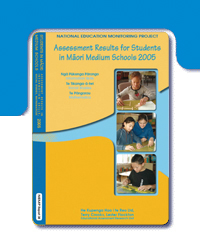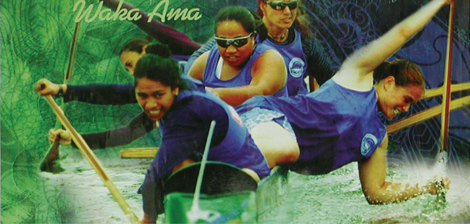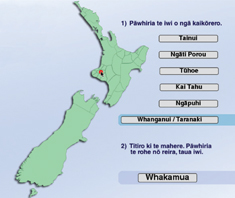|
FOCUS / FORUM
INDEX
|
 |
In 2008, the Forum Comment,
was relaunched as the Focus
reflecting the closer comment from
NEMP and the panel of educators. |
 |
|
Main Index for Focus / Forum
Introduction
to Focus / Forum
He
Whakaputanga Whakaaro –
Introduction for Mäori
Medium forums
|
| Forums by year of assessment |
|
|
|
Science
Art
Graphs, Tables & Maps
|
|
|
|
Music
Aspects of Technology
Reading & Speaking |
|
|
|
Information
Skills
Social Studies
Mathematics |
|
 |
|
Listening
& Viewing
Health & Phys. Ed.
Writing |
|
| Forums for Mäori Medium |
|
|
|
Science
Art
Graphs, Tables & Maps
|
|
|
|
Music
Aspects of Technology
Reading & Speaking |
|
|
|
Information
Skills
Social Studies
Mathematics |
|
 |
|
Listening
& Viewing
Health & Phys. Ed.
Writing |
|
|
|
|
|
 |
|
|
  |

CLICK
on cover above for full 2005 report
|
|
|
Kei te hängai te titiro a ngä tängata
o Aotearoa ki te ekenga paetae a ngä äkonga
me te kounga o te mätauranga. He wähanga te
Kaupapa Aroturuki Mätauranga ä-Motu
(NEMP) o te rautaki a te Käwanatanga ki te tukutuku i ënei
pärongo.
New
Zealanders are interested in student achievement and the
quality of education. The National Education Monitoring Project
(NEMP) is part of Government strategy to provide this information. |
| |
 |
| |
| IMPORTANT
NOTE RE TRANSLATION: Translations for each 'He Whakaputanga
Whakaaro' and report are historic, reflecting the translation
as at the time of printing. Variations in translation
may therefore occur from one year to the next. |
| |
| WHAKATAKI
2005 |
 |
INTRODUCTION
2005 |
I
te tau 2005 ka aromatawaia e NEMP tëtahi
tïpako ä-motu o ngä äkonga tau 8 i ngä kura
reo Mäori. Kei roto ngä hua taipitopito i te pürongo
a NEMP, Ngä Hua Aromatawai o ngä Äkonga i ngä Kura
Reo Mäori 2005 – Pükenga Pärongo, Tikanga ä-Iwi,
Pängarau. I äta whakaarotia te pürongo e tëtahi
röpü o ngä kaiwhakaako kura reo Mäori me
ngä äpiha tautoko o te Tähuhu o te Mätauranga.
Kei tënei Whakaputanga Whakaaro te whakaräpopoto
o ö rätou whakaaro mö te pürongo.
Kei te mihi ki ngä tumuaki, ki ngä kaiwhakaako me
ngä poari kaitiaki nä rätou i whakamöhio
whänui te pürongo a NEMP me tënei Whakaputanga
Whakaaro, ä, kei te whakatenatena mätou i a rätou
ki te mahi tonu i tënei mahi.
|
|
In
2005, NEMP assessed a national sample of year 8 students
in Mäori medium education. Detailed results
are given in the NEMP report, Assessment Results for Students
in Mäori Medium Schools 2005 – Information Skills,
Social Studies, Mathematics. The report has been considered
by a forum of Mäori medium educators and Ministry of Education
representatives. Their response to the report is given in this
Forum Comment.
The help of principals, teachers and Boards of Trustees in
making the NEMP report and this Forum Comment widely known
is encouraged and appreciated.
|
| |
|
|
NGÄ
PÜKENGA PÄRONGO
|
|
INFORMATION
SKILLS |
NGÄ ÄHUATANGA
PAI
-
Ka ähei te tokomaha o ngä äkonga te pänui
me te tango pärongo whänui mai i te maha o ngä mätäpuna.
-
Ähua pai tonu te tokomaha o ngä äkonga
ki te whakaraupapa me te whiriwhiri pärongo.
-
He pai ki ngä äkonga ngä mahi rapu pärongo.
HE ÄWANGAWANGA
-
He uaua ki ngä äkonga te whakahängai
i ö rätou ake möhiotanga me ö rätou
wheako ki ngä tüähua me ngä take whänui
atu.
-
He uaua ki te tokomaha o ngä äkonga te arotake
whakaaro mai i ngä tuhituhinga, tae atu ki te whakahua
me te parahau i ä rätou ake tirohanga.
-
Käore i te märama ki te tokomaha o ngä äkonga
ngä hoahoa e whaitake ana mö te whakaräpopoto
me te hopu pärongo.
TE TIRO WHAKAMUA
Me tuku äwhina ki ngä äkonga ki te whakawhanake
i ö rätou pükenga rangahau, arä:
-
kia möhio, kia whakamahi rätou i te maha o
ngä mätäpuna pärongo hei kohikohi pärongo
mö tënä kaupapa, mö tënä kaupapa.
-
te whiriwhiri i te hängai me te tötika o ngä pärongo
ka kohia.
-
te hono i te pärongo ki ngä take me ngä whakaaro
whänui atu.
-
te whakamahi
i ngä momo hoahoa mö te whakaräpopoto me te
hopu pärongo.
-
te whiriwhiri me te parahau tirohanga
ka pä ki ëtahi
pärongo.
|
|
Good
News
-
Many
students are capable of reading and extracting general
infor-mation from a range of sources.
-
Many
students were able to sequence and process information
relatively well.
-
Students
have positive attitudes towards activities that involve
looking for information.
Concerns
-
Students
generally had difficulty relating their immediate background
knowledge and experiences to broader situations and issues.
-
Many
students had difficulty evaluating ideas from a text,
and expressing and justifying opinions.
-
Many
students were unfamiliar with different
types of diagrams which are useful for summarising and
recording information.
Looking Ahead
Students need help to develop research skills of:
-
knowing
and using a range of sources for gathering information
for particular purposes.
-
making
judgements about the validity and suitability of information
obtained.
-
connecting
information to wider issues and ideas.
-
using
different types of diagrams for summarising and recording
information.
-
forming
and justifying opinions about information.
|
| |
|
| |
TE
TIKANGA-Ä-IWI
|
|
SOCIAL
STUDIES |
NGÄ ÄHUATANGA PAI
-
Ahakoa te mea käore ngä äkonga i whirinaki
ki a ia, e ai ki te rangahau a NEMP, ka pai te Tikanga ä-Iwi
ki a rätou.
-
I tareka e ngä äkonga te tohu he aha ngä take
ka whai wähi ki te tipu o te raruraru i roto i ngä kura.
-
He tokomaha ngä äkonga i taea te whakaahua
tëtahi, ëtahi wähanga ränei o te raupapa
mahi i te pöwhiri.
-
He tino teitei te örau o ngä äkonga i
taea te hömai whakautu tötika ki ngä ähuatanga
o ngä ngohe e pä ana ki te kaiärahitanga, ki
te tautohu me te urupare ki te mate whawhati tata, te märama
ki ngä tohu ahurea rongonui, te möhio mö ngä piki
me ngä heke o te wä, me ngä tüwähi
o Aotearoa.
HE ÄWANGAWANGA
-
He uaua ki ngä äkonga te hono whakaaro ki
ngä take whänui, te tautohu me te whakawhitiwhiti
körero mö te whänuitanga o ngä ariä,
ngä tirohanga, ngä whanonga, ngä rautaki
ka taea.
-
He iti noa iho ngä möhiotanga o te nuinga
o ngä äkonga mö te tikanga o te pöwhiri.
-
Käore i whänui te titiro a ngä äkonga
ki ngä ähuatanga matua o te ärahitanga
pai.
-
He uaua ki ngä äkonga te
whenu Rauemi, Ngohe Ohaoha.
-
I taea e te nuinga o ngä äkonga te körero
mö ö rätou ake iwi, häunga, të taea
he körero mö ëtahi atu iwi.
TE TIRO WHAKAMUA
-
He mea nui kia awhi i ngä äkonga e möhio
ai rätou, e körero ai rätou mö te höhonutanga
o ngä kawenga me ngä tikanga ä-iwi.
-
Me huaki ngä tuwheratanga ki ngä äkonga
kia nui atu ai ö rätou möhiotanga, kia märama
atu ai rätou, kia mäia ai rätou ki te whakawhitiwhiti
körero mö ngä take nui o te rohe, o te
motu, o te ao.
|
|

Good News
-
While Social Studies
ranked low among students’ subject
preferences, they indicated positive attitudes nonetheless
towards this learning area in the NEMP survey.
-
Students were successful in identifying the issues
leading to a school conflict situation.
-
A large percentage
of students were able to give at least some description
of the sequence of events of a pöwhiri.
-
High percentages of students were able to give
some appropriate answers to aspects of tasks about leadership,
identifying and responding to crises, recognising cultural
icons, knowing about current events, and locations within
Aotearoa New Zealand.
CONCERNS
-
Students had difficulty connecting ideas
to wider issues and identifying and discussing a range
of possible ideas, opinions, behaviours and strategies.
-
Most students were only able to give
limited explanations of tikanga involved in a pöwhiri.
-
Students had quite limited ideas
about the important qualities of good leadership.
-
The Resources and Economics Activities
strand proved challenging for students.
-
Although most students were able
to describe and identify their own tribal origins, few
had knowledge of tribes outside their own areas.
LOOKING AHEAD
-
There is a need to help students
know and talk about the underlying meanings of cultural
practices and responsibilities.
-
Students need opportunities
that help them to have greater awareness, understanding
and confidence in discussing significant events and
issues at local, national and world-wide levels.
|
 |
|
TE
PÄNGARAU
|
|
MATHEMATICS |
NGÄ ÄHUATANGA
PAI
- I
pai te mahi o te nuinga o ngä äkonga i ngä ngohe
e pä ana ki te whakaputa mahara i ngä meka matua
täpiritanga, whakareatanga hoki.
- He tokomaha ngä äkonga i möhio ki te
tätai e hia ngä toenga moni ka whiwhi rätou
ina hoko taputapu rätou.
- He tokomaha ngä äkonga he pai ki a rätou
ki te ako pängarau.
- E ai ki ngä äkonga, ko te pängarau tëtahi
o ngä kaupapa ako e toru e tino ngäkaunuitia
ana.
HE ÄWANGAWANGA
- E ai ki te nuinga o ngä äkonga, he nui atu
te möhio ki ngä meka matua me ngä pükenga
pängarau tërä i ngä pükenga whakaaro,
whakaoti rapanga.
- He uaua ki te tokomaha o ngä äkonga ngä ngohe
aromatawai e pä ana ki te pänui me te whakamärama
pärongo tuhituhi.
- He uaua ki te nuinga o ngä äkonga te whai
i te whänuitanga o ngä pükenga me ngä hätepe
pängarau (përä i te tau, te mahi taurangi, te
ine, te ähuahanga) ina i runga ake ngä ngohe i ngä taumata
tino mämä.
- He tokomaha ngä äkonga i ähei te tätai
i ngä rapanga mämä, whai kaupae tahi, häunga
ngä rapanga kaupae rua, neke atu.
TE
TIRO WHAKAMUA
- I runga i ngä hua aromatawai, me ngana kia whaitake,
kia tötika ngä horopaki me ngä wheako pängarau
ka whakaratoa mö ngä äkonga, ä, e takea
mai ana i te reo me te whakawhitiwhiti körero.
- He whïwhiwhi te hanganga o te reo mö ngä äkonga
kei te ako i te pängarau i roto i te reo Mäori. He
awe nui tënei i te whanaketanga ngaio o ngä kaiako
me te whanake haere o ngä rauemi tötika hei tautoko
i ngä akoranga me te ako.
|
|
GOOD
NEWS
- Most
students performed well on tasks involving recall of
basic addition and multiplication facts.
- A
large percentage of students were competent in calculating
the amount of change expected from money tendered for
purchases.
- A
large percentage of students have positive attitudes
towards learning mathematics.
- Students
rated mathematics as one of the top three most popular
subjects.
CONCERNS
-
Most
students considered knowledge of basic facts and arithmetic
skills as more important than thinking and problem
solving skills.
-
Many
students had difficulty with mathematical tasks that
involved reading and interpreting written information.
-
Most
students had difficulty across a broad range of mathematical
skills and processes (number and algebra, measurement
and geometry) when tasks progressed beyond very basic
levels.
-
Many
students were able to calculate uncomplicated, single-step
problems but had difficulty when problems involved more
than one step of processing.
LOOKING
AHEAD
-
Results
show that there is a need to expose students to meaningful
and well chosen mathematical contexts and experiences
that are embedded in language and discussion.
-
Student
learning in mathematics through te reo Mäori
involves complexities of language structure. This has
important implications for professional development of
teachers and the continued creation of resources that
are effective in supporting teaching and learning.
|
 |
NGÄ
MÄTÄTAKI AROMATAWAI
|
|
ASSESSMENT
CHALLENGES |
- I ahu mai
ngä äkonga katoa
i whai wähi ki te tïpako ä-motu i ngä Kura
Kaupapa Mäori, Kura Mana Mäori, Kura Rumaki Mäori
hoki. He tau 8 katoa ngä äkonga, ä, e whä tau
neke atu ränei te roa o tä rätou noho ki tëtahi
kura reo Mäori.
- Häunga te mea i whakaatu ngä äkonga i
tö rätou matatau whänui ki te körerorero
i roto i te reo Mäori o ia rä, he tino rerekë ngä tautöhito
reo Mäori i roto i te horopaki mätauranga.
- Ruarua noa iho ngä ngohe aromatawai i whakahiatotia
mai i ngä whitiwhitinga körero i tëtahi hui
o ngä kaiwhakaako kura reo Mäori o te tau 8. Ko te
toenga o ngä ngohe aromatawai he whakamäoritanga,
he urutaunga ränei o ngä ngohe NEMP i roto i te reo
Ingarihi. Kua mutu te whakataurite a NEMP i ngä äkonga
Mäori kei ngä akoranga auraki ki ngä äkonga
i ngä mätauranga rumaki. Nä reira, ka ähei
te whakahängai, te whakaatu rerekë i ngä ngohe,
hei aha te whakamäori tautika i ngä mahinga përä i
ngä tau ki mua.
- I whakahaeretia ngä ngohe aromatawai e ëtahi
kaiwhakaako i whakangungu motuhaketia, he wheako ö rätou
i te whakaakoranga i ngä kura reo Mäori.
- I whakahuia ngä kaiwhakaako mai i ngä kura
e whai wähi ana, ki te arotake me te hömai urupare
mö ngä hua aromatawai me te pürongo e whakakaupapatia
ana.
- E nui atu ai te whaitake a NEMP, kei te whakaratoa
e te Tähuhu o te Mätauranga he mökï ki
ngä kura reo Mäori katoa, kei roto ëtahi ngohe,
rauemi, tohutohu aromatawai hoki ka whakamahia i roto i te
hötaka aromatawai.
- I runga i te tikanga aromatawai o ngä pürongo
tätainga whänui, käore i te äta kitea he
tino pai rawa atu ngä hua a ngä äkonga i ëtahi
kura.
- Ka miramira ngä hua aromatawai i ëtahi ia,
i ëtahi take hoki ka taea te whai wähi ki ngä mahi
a ngä kaiako me ngä kura, tae atu ki ngä kaupapa
nui mö te whanaketanga ngaio o ngä kaiako.
|
|
-
All
students in the national sample attended either Kura Kaupapa
Mäori, Kura Mana Mäori, or full Mäori immersion
schools. All students were at the year 8 level and had at
least 4 years of Mäori medium education.
-
Although students showed general proficiency in te
reo Mäori in ordinary everyday conversation, academic
competency in the language varied widely.
-
A small number of the assessment tasks were developed
from ideas put forward at a meeting of year 8 Mäori medium
teachers. The balance of tasks were translated and adapted
from NEMP English medium tasks. NEMP no longer compares Mäori
students in general education with those in immersion education.
This means that tasks could be contextualised or expressed
in different ways as opposed to the direct translation
approach of previous years.
-
The tasks were administered by specially trained
teachers with experience in Mäori medium teaching.
-
Personnel
from the participating schools were brought together
to review and give feedback on the results and the proposed
report.
-
To help increase the usefulness of NEMP, the Ministry
of Education is providing all Mäori medium schools
with a pack containing a selection of tasks, materials
and marking guides used in the assessment programme.
-
As
with all assessments that report overall scores, the
fact that there are high performances by students in
some schools is not readily apparent.
-
The
assessment results highlight a number of trends and issues
that have the potential to inform the practice of teachers
and schools, and priorities for the professional development
of teachers.
|
| |
|
|
| TE
KURA REO MÄORI |
-
Kua whanake haere te mätauranga kura reo Mäori
i roto i ngä tau e 20 kua pahure, ä, e whanake
haere nei.
-
He maha, he rerekë ngä hötaka o ngä kura
reo Mäori. He rerekë hoki te matatau reo o ngä kaiako
me ngä äkonga i ënei hötaka. Körero
ai, whakaaro ai hoki ngä kaiako me ngä äkonga
i ngä horopaki kura reo Mäori i ëtahi reo e
rua, käore tënei ähuatanga e pä ki
te nuinga o te taupori o Aotearoa.
-
I tua atu i te mahi i raro i te Marautanga
o Aotearoa, ka tautoko, ka häpai te mätauranga kura reo Mäori
i tëtahi kaupapa ahurei ki te ‘tü hei Mäori’.
Ka tareka tënei mä roto i te reo Mäori.
|
| |
| MÄORI
MEDIUM EDUCATION |
-
Mäori medium education has evolved
over the last 20 years or so and it is still evolving.
-
Mäori medium programmes are many and varied. The
language fluency of staff and students in these programmes
is also diverse. Staff and students within Mäori medium
settings think and speak in two languages, which is not the
case for the majority of New Zealand’s population
.
-
As well as working within the New Zealand
Curriculum, Mäori medium education fosters and advances a particular
philosophy which is unique to ‘being Mäori’.
This is achieved substantially through the medium of te reo
Mäori.
|
|
 |
|
|